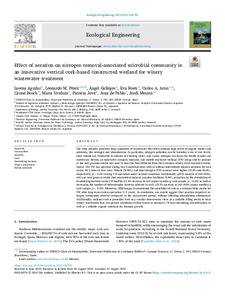Por favor, use este identificador para citar o enlazar este ítem:
https://repositorio.uca.edu.ar/handle/123456789/15215| Título: | Effect of aeration on nitrogen removal-associated microbial community in an innovative vertical cork-based constructed wetland for winery wastewater treatment | Autor: | Aguilar, Lorena Pérez, Leonardo Martín Gallegos, Ángel Forés, Eva Arias, Carlos A. Bosch, Carme Verdum, Maria Jove, Patricia de Pablo, Joan Morató, Jordi |
Palabras clave: | INDUSTRIA VITIVINICOLA; VINOS; CONTAMINACION POR NITRATOS; FLUJO VERTICAL; CORCHO; AIREACION; AGUAS RESIDUALES; BODEGAS; BACTERIAS DESNITRIFICANTES | Fecha de publicación: | 2022 | Editorial: | Elsevier | Cita: | Aguilar, L. et al. Effect of aeration on nitrogen removal-associated microbial community in an innovative vertical cork-based constructed wetland for winery wastewater treatment [en línea]. Ecological Engineering. 2022, 185. doi: 10.1016/j.ecoleng.2022.106781.Disponible en:https://repositorio.uca.edu.ar/handle/123456789/15215 | Resumen: | Abstract: The wine industry produces large quantities of wastewater that often contains high levels of organic matter and nutrients, like nitrogen and phosphorous. In particular, nitrogen pollution can be harmful, even at low levels, since infants are vulnerable to nitrates in drinking water, and excess nitrogen can harm the health of soils and waterways. Herein, an innovative compact, modular, and mobile treatment wetland (TW) using cork by product as the only granular media was used to treat the final effluents from the Codorniu winery (Sant Sadurní d'Anoia, Spain). The TW was operated during two 5-month periods with or without intermittent induced aeration (40 min cycles, 90 L/min air flow rate). Nitrate (N-NO3) and total nitrogen (TN) removal were higher (52.8% and 46.8%, respectively, p < 0.05) during TW operation under aerated-condition. Additionally, qPCR analysis of 16S rRNA, nirS and nosZ genes revealed that intermittent induced aeration facilitates N-NO3 reduction by the stimulation of denitrifying bacteria in the TW biofilm (11.4% increase in nirS copies number/g cork sample, p < 0.05) as well as increasing the number of heterotrophic bacteria adhered to cork (25.5% increase in 16S rRNA copies number/g cork sample, p < 0.05). Moreover, SEM images demonstrated the suitability of cork as a resistant filter media for TW after long-term system operation (1.5 years). In conclusion, our results suggest that aeration improved nitrogen compounds removal compared to the non-aerated period, without affecting phosphorous elimination. Additionally, residual cork is presented here in a circular bioeconomy view, as a suitable filling media to treat winery wastewater that can provide additional carbon source to increase C/N rate stimulating denitrification, as well as a reliable organic substrate for biomass growth. | URI: | https://repositorio.uca.edu.ar/handle/123456789/15215 | ISSN: | 0925- 8574 | Disciplina: | QUIMICA | DOI: | 10.1016/j.ecoleng.2022.106781 | Derechos: | Acceso abierto | Fuente: | Ecological Engineering. 2022, 185 |
| Aparece en las colecciones: | Artículos |
Ficheros en este ítem:
| Fichero | Descripción | Tamaño | Formato | |
|---|---|---|---|---|
| effect-aeration-nitrogen.pdf | 1,54 MB | Adobe PDF |  Visualizar/Abrir |
Visualizaciones de página(s)
49
comprobado en 27-abr-2024
Descarga(s)
48
comprobado en 27-abr-2024
Google ScholarTM
Ver en Google Scholar
Altmetric
Altmetric
Este ítem está sujeto a una Licencia Creative Commons

